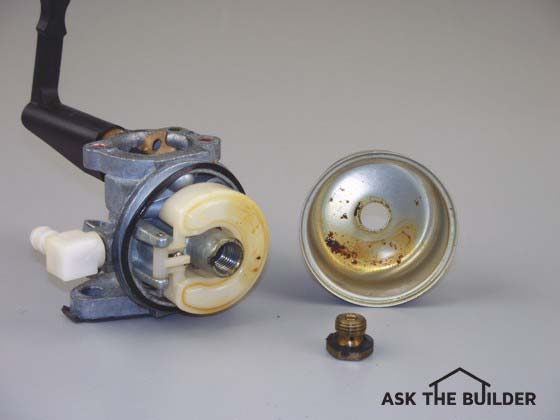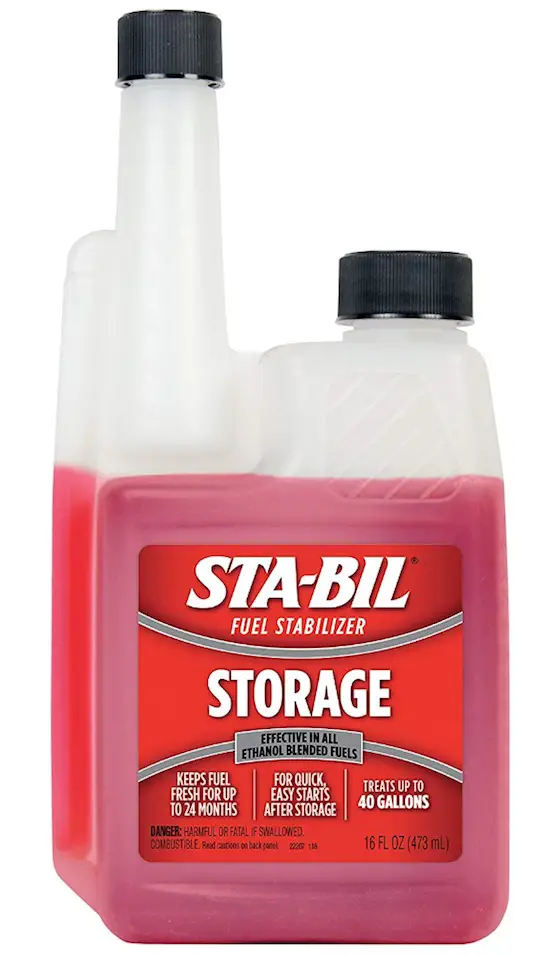Small Engine Care and Storage Tips

Gum and varnish build-up inside a small engine carburetor will eventually lead to problems. The secret tips below are SO GOOD I shared them with 31,000 subscribers who read my November 15, 2020 FREE newsletter. Copyright 2018 Tim Carter
"Gasoline begins to degrade about thirty days after it's pumped."
Small Engine Care and Storage TIPS
- Use ethanol-free gasoline
- Thousands of stations sell it
- Use best fuel stabilizer
- Keep gas tanks filled all the time
- CLICK HERE to Get Tim's FREE & FUNNY Newsletter!
Want to listen to this column? Use the following audio player:
DEAR TIM: Spring has finally arrived in the high country here. It's time to cut the grass, but the small gasoline engine on my lawn mower refuses to start. I use the same gasoline that goes in my truck, and my truck always starts.
My guess is that you work with small engines all the time and know what the problem might be and how to prevent it.
What's the best way to store a small engine for months so when it's time to use it you can depend on it starting? Don G., Baker, NV
DEAR DON: I used to have hard-start issues with small engines. I've also had small engines that refused to start no matter how much starting fluid you squirt in the air filter.
How Can I Start Engine First Pull?
You can have your small engine start first pull if you do the following:
- store the engine with a full tank of gas
- use 91 octane or higher gas with stabilizer
- start the engine every 30-45 days to keep fuel in the carburetor
Years ago I discovered a trick that ensures my small engines start the first pull each time I take them out of winter or summer storage.
CLICK HERE to get FREE & FAST BIDS from local handymen that can clean your small engine carburetor.
Your truck starts all the time because you drive it frequently and the gasoline in the tank and fuel system are almost always fresh. If you add gasoline to your truck every thirty days, you'll rarely have problems.
People that don't drive their cars much should absolutely continue reading because they need to do what I do with my small engines.
Did You Talk With a Briggs & Stratton Engineer?
I decided that I'd blend my years of personal experience with the vast knowledge base of Briggs & Stratton's Wayne Rassel, an engineer, to shed some light on how to store small engines. I have small engines in snow blowers, a lawn mower, a hydraulic log splitter and a standby generator. All the engines sit idle for months at a time, so it's important that they respond when I need them.
What are the Best Storage Practices?
I discovered a simple trick years ago that allows my engines to start each time I pull the starting cord. But information I got from Wayne has caused me to modify my approach to storing small gasoline engines.
Now I incorporate the best practices known to woman or man about how to ensure small engines start.
Is Ethanol BAD for Small Engines?
Yes, ethanol is very bad for small engines and even larger ones like in your car or light truck.
The gasoline you and I purchase contains 10-percent ethanol. Using gasoline that contains more than 10-percent ethanol can cause significant damage to small engines, so avoid it at all costs.
If you want to put the best gas in your small engines, get ethanol-free gasoline.
Where Can You Find the Best Gasoline?
There is a website called pure-gas.org that has a list of over 10,000 locations, broken down by states or provinces, that sell pure, ethanol-free gas.
If you can't locate a station near you, just visit your local small airport. All aviation gasoline is ethanol-free. You can buy great gasoline at any small airport.
Some boat marinas may also sell ethanol-free gasoline.
CLICK HERE to get FREE & FAST BIDS from local handymen that can clean your small engine carburetor.
Does Gasoline Break Down?
Gasoline begins to degrade about thirty days after it's pumped. If you've not used all the gasoline in your gas cans within that time frame, pour it into your truck's fuel tank and drive to the gas station to get fresh fuel for your small engines.
That's what I do. I never put gasoline in my small engines that's older than thirty days.
What is the Chemistry of Gasoline?
Understand that ethanol-based fuels tend to attract water. Water is heavier than gasoline.
IMPORTANT TIP: If you don't operate your engines on a frequent basis, a layer of ethanol-enriched water can settle to the bottom of the tank and be drawn up into the carburetor and engine.
This water-ethanol blend is highly corrosive to small engine parts.
How Does Gum & Crap Form?
Gum and varnish, chemical compounds in the gasoline, form as the fuel degrades. This gum and varnish can lead to stuck intake valves, clogged fuel lines and jets in the carburetor.
This could be why your engine is refusing to start. It could be clogged with this gunk.
Should the Tank Be Filled at All Times?
I keep my small engines in great shape by keeping the gas tank filled to the brim at all times. I do this after I shut the engine off.
I do this even if I'm going to use the engine in a week. Keeping the tank filled with fuel minimizes the oxygen in the tank.
Oxygen reacts with gasoline causing degradation.
BEST Storage Tip - Fill 'er Up With Stabilized 91-Octane Gas
At the end of each season, I discovered that if I ran the engine completely out of gas right before storing it for months, I'd be able to restart the engine with no issues. However, after talking with Wayne, I've decided that state-of-the-art fuel treatments and stabilizers are probably the best way to protect my small engines throughout the entire year.
You also want to use 91-octane gasoline too unless you go to a local small airport and get higher octane gas with NO ethanol in it. Ethanol is NOT permitted in small-aircraft engines so I'm told.
What About Modern Stabilizers?
Some modern fuel additives have a triple anti-oxidant formulation that slows down the fuel degradation issue. The chemicals in the additives react with the gasoline preventing outside water vapor from causing the gasoline to deteriorate.
The additives protect the entire fuel system and all engine parts exposed to the gasoline. Metal parts receive a protective coating that prevent rust and corrosion.

This is the brand I use to keep my small engines in great shape. CLICK or TAP HERE or the image to have it delivered to your home.
Metal deactivators in the additives stop aggressive chemical reactions caused by dissolved metal ions in the fuel. Detergents in the additives help prevent the formation of the gum and varnishes that cause hard or no-starting issues.
You can get long-lasting results if you decide to use the advanced formula fuel stabilizers. If you want two years of protection, just add one-half ounce to each 2.5 gallons of gasoline. Double the amount of stabilizer and you can protect gasoline up to three years.
Since I take a conservative approach to small engine care and maintenance, I'm going to start to add the fuel stabilizer to all my gasoline. I want to protect the metal parts in my engine. The fuel stabilizers are not expensive, and one 8-ounce bottle treats up to 40 gallons of gasoline. Believe me, I can blow lots of snow and cut lots of grass with 40 gallons of gasoline!
CLICK HERE to get FREE & FAST BIDS from local handymen that can clean your small engine carburetor.
A small engine reminder was featured in my June 25, 2013, April 13, 2014 and my January 25, 2017 AsktheBuilder Newsletter.
Column 992
52 Responses to Small Engine Care and Storage Tips